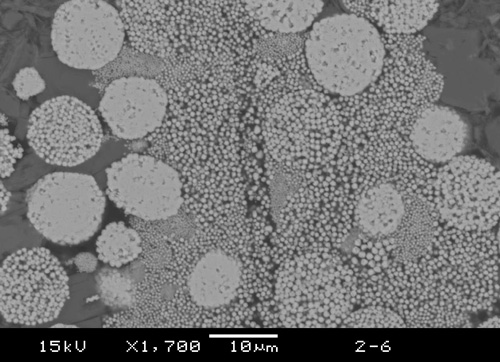Several people guessed – or got within honorable spitting distance of guessing – that the SEM picture I showed you on Friday was of an aggregate of pyrite (FeS2) – the iron sulphide more commonly known as ‘fools gold’. As it turns out, however, things are not quite that simple. Hiding amongst the pyrite is another mineral, one responsible for more than its fair share of confusion and headaches during the course of my PhD research.

This pyrite aggregate is from uplifted Late Miocene (6 to 10 million year-old) sediments from New Zealand. Pyrite is often found in marine sediments, and it often has the ‘framboidal’ texture that you can see in the image above, where the cubic pyrite crystals are arranged into larger spheres (‘framboid’ is derived from ‘framboise’, the French for raspberry). Because pyrite is not particularly stable in the presence of oxygen, all this pyrite is unlikely to have settled out of the water column; instead, it has grown within the sediments after deposition. As sediments are progressively buried, compacted, and eventually lithified, they are subjected to many geochemical changes which will lead to the dissolution of some minerals, and the formation of new ones – a process known as diagenesis. Pyrite formation occurs in the anoxic lower regions of the sediment column, where sulphate-reducing bacteria extract energy from buried organic matter by converting sulphate (SO4) to sulphide (H2S), which then reacts with detrital iron minerals to form pyrite.
This process is of concern to palaeomagicians for two reasons. Firstly, one of the detrital iron minerals being dissolved during this process is magnetite; if sulphate reduction is intense enough, the concentration of magnetite within the sediment can be reduced by an order of magnitude or more, making it much more difficult to extract useful palaeomagnetic information. But perhaps more significantly, pyritization reactions are quite complex, involving a series of intermediate iron sulphide phases. One of these intermediates is a mineral known as greigite (Fe3S4), which has precisely the same mineral structure as magnetite (Fe3O4), just with sulphur atoms replacing the oxygen. And, just like magnetite, it can retain a stable remanent magnetisation*.
None of this would matter too much if all of the greigite was eventually converted to pyrite, or it all formed very early during sediment diagenesis. Unfortunately, neither of these is the case. Elemental analysis of the SEM image above indicate that the patches of slightly finer-grained iron sulphides (marked with a ‘G’ in the image below) are magnetic greigite, rather than non-magnetic pyrite. It seems that the reactions forming pyrite do not always reach completion, preserving greigite over geological timescales. At the same time, the pyritization reactions are dissolving all the magnetite, meaning that even small amounts of greigite could be very significant palaeomagnetically.

Furthermore, a close examination of the growth textures in this iron sulphide aggregate indicate that it is the end product of not one, but several, episodes of growth. First, you have the neat little framboids, which probably formed quite early on; then later, you have one or two slightly less organised ‘space-filling’ episodes of growth. Most of the preserved greigite seems to be associated with these later episodes; unfortunately, there’s plenty of geological evidence that ‘later’ could mean anything from a few thousand, to a few million years, and at present it is very difficult to distinguish which. Thus, greigite is a bastard, and trying to do detailed palaeomagnetic studies on rocks where the magnetic signal is carried by greigite is something that you should avoid at all costs. It was therefore quite unfortunate that it took me until the end of the third year of my PhD to look at all my New Zealand samples under the SEM…
*Some people have speculated that it is during the greigite phase that all the crystals are aligned to form the framboids.



Comments (7)